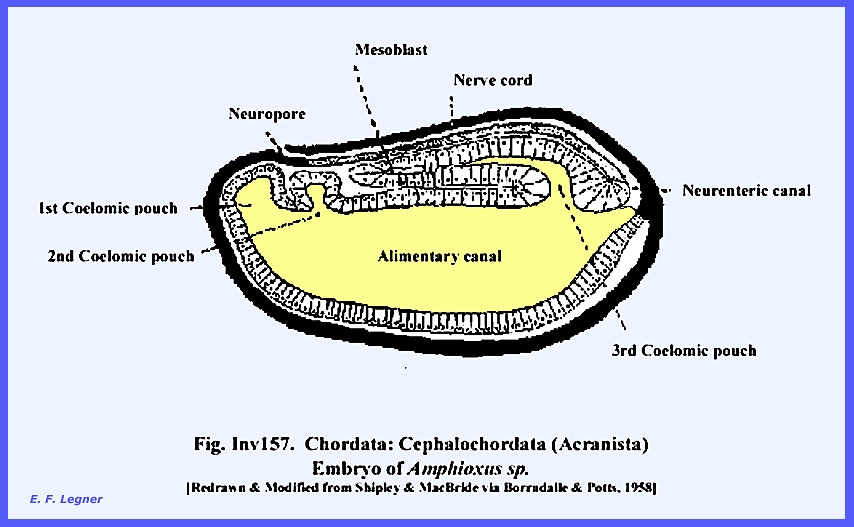File:
<mollusca.htm> <Index to Invertebrates> <Bibliography> <Glossary> Site Description
<Navigate to Home>
|
Invertebrate
Zoology Kingdom: Animalia, Phylum: Chordata (Contact) Phylum: Chordata Subphylum Urochordata (Tunicata) — (tunicates; 3,010 species) Class Ascidiacea Class Thaliacea (salps) Class Appendicularia (larvacea)
Subphylum Cephalochordata (Acraniata) —
(lancelets; 29+ species)
Subphylum Vertebrata (Craniata) (vertebrates-animals with backbones;
57,690 species) Class 'Agnatha' paraphyletic (jawless
vertebrates; 105+ species) Subclass Myxinoidea (hagfish; 67 species) Subclass Petromyzontida (lampreys) Subclass Conodonta Subclass Pteraspidomorphi (Paleozoic jawless
fish) Order Anaspida Order Thelodonti (Paleozoic jawless
fish) Infraphylum Gnathostomata (vertebrates) Class Placodermi (Paleozoic armoured forms) Class Chondrichthyes (cartilaginous fish; 890+
species) Class Acanthodii (Paleozoic "spiny
sharks") Class Osteichthyes (bony fish; 30,000+ species)
Subclass Actinopterygii (ray-finned fish;
about 29,500 species) Subclass Sarcopterygii (lobe-finned fish) Superclass Tetrapoda (four-legged vertebrates;
18,010+ species) Class Amphibia (amphibians; 5,995 species)
Series Amniota (with amniotic egg) Class Reptilia (reptiles; 8,200+ species)
Subclass Anapsida
(extinct "proto-reptiles" and possibly turtles) Subclass Synapsida (mammal-like
"reptiles"; 4,510+ species, progenitors of mammals) Subclass Diapsida (majority of reptiles,
progenitors of birds) Class Aves (birds; 8,700–10,025 species) Class Mammalia (mammals; 5,700 species) |
-------------------------------------------------
|
The Phylum Chordata are
animals that are either vertebrates or one of several closely related invertebrates. They are
similar by having in at least some period of their life cycle, a notochord, a hollow
dorsal nerve cord, pharyngeal slits, an endostyle, and a post-anal appendage or tail.
Included here are some groups that resemble invertebrates and may be
transferred to that category as more data on their behavior, morphology and
DNA is obtained.
Several hypotheses have been proposed for the evolutionary
relationships of the Chordata. It is
believed that they are monophyletic by having descendants of a single common
ancestor. The earliest fossils are
from the Early Cambrian period, which includes two species of fish-like
animals. Authorities have found it
difficult to give a detailed classification within the living Chordata, so
that more studies are required to resolve this. ------------------------------------ Subphylum Urochordata (Tunicata) — (tunicates; 3,010 species) All
members of this subphylum inhabit marine environments. They are also known as sea squirts, which are sessile as adults and permanently
fastened.
Body Plan. -- At the upper end of the animal there
is an incurrent siphon or oral
siphon and en excurrent siphon or atrial siphon. The oral
siphon leads to a large pharynx, which possesses a great number of ornate
gills that open into the atrium. The
U-shaped digestive tract loops into the base and then back again, with the
anus opening into the atrium.
Reproduction. -- The animals are all hermaphroditic.
Nervous System. -- There is a single ganglion located
between the two siphons.
Body Wall. -- A heavy layer called the "Tunic" composed largely of cellulose forms the body
wall.
Embryology. -- The egg develops into a larval form
called a tadpole. The tadpole
larva has a dorsal nollow nervous system and a notocord in the tail. There are also gill slits. These are all features of the Chordata.
The tadpole settles down and becomes permanently attached by adhesive papillae. Degenerative metamorphosis occurs
to the adult stage. It has been suggested
that the Vertebrata evolved from the tadpole larva.
Circulation. -- A reversible heart pumps one direction first and then the
other direction. There is a
respiratory pigment of vanadium. ------------------------------------ Subphylum Cephalochordata (Acraniata) — (lancelets; 29+ species)
All characteristics of the Chordata appear in this subphylum. The gill slits open into the atrium, there
is a well developed notochord and a well developed dorsal, hollow nerve
cord. The embryology shows all
features of Tunicata, Echinodermata and Enteropneusta. Sample Examinations Invertebrate
Classification ============== |

